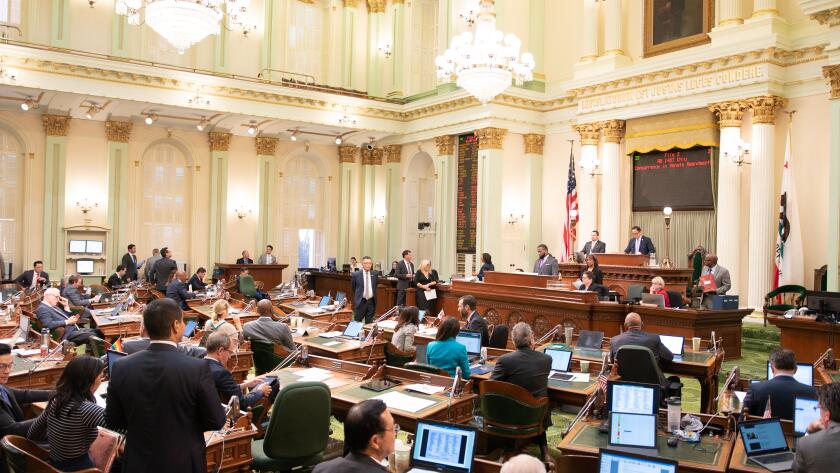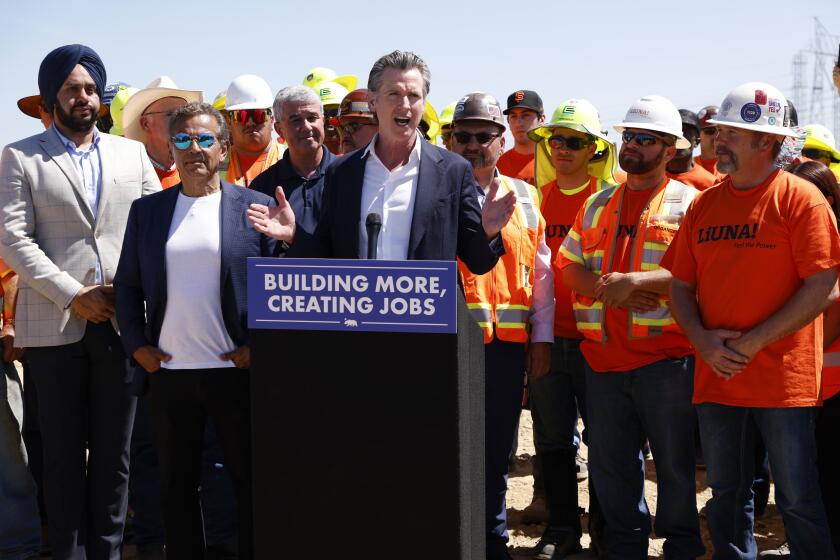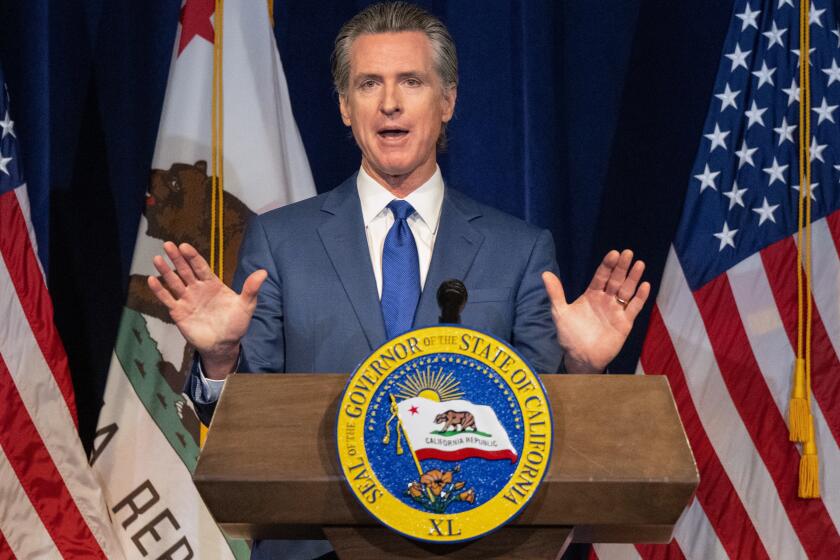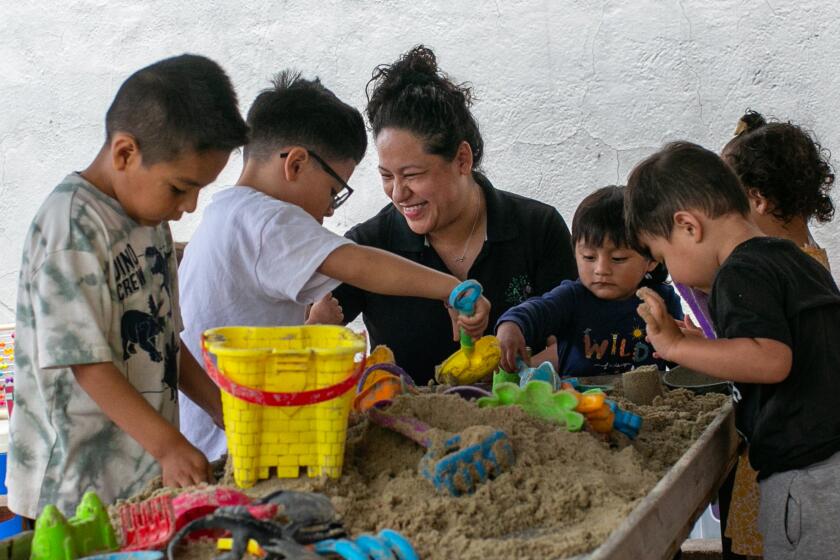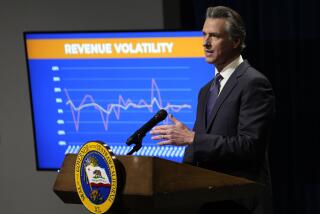Takeaways from the California budget deal between Newsom and Democratic lawmakers
- Share via
Gov. Gavin Newsom and California lawmakers agreed to a $310.8-billion budget deal that will include an expansion of Medi-Cal coverage and transforming parts of San Quentin State Prison into a rehabilitation center.
- Share via
Gov. Gavin Newsom and Democratic legislative leaders on Monday agreed to a $310.8-billion spending plan that will reduce investments in fighting climate change and reflects a compromise on the governor’s last-minute proposal to speed up infrastructure projects across California.
The 2023-24 budget deal, which lawmakers will vote on in a series of bills this week, ends weeks of infighting among Democrats that began after the governor introduced a package of infrastructure bills at the tail end of the budget process, including making it easier to approve his highly controversial plan to build a $16-billion tunnel beneath the Sacramento-San Joaquin River Delta to transport water south.
Newsom threatened to veto the Legislature’s budget priorities over the last week unless they approved his infrastructure plan. The two sides ultimately settled on a deal that removes the delta tunnel project from the package but retains measures to reduce delays to other major projects due to legal challenges under California environmental law.
“In the face of continued global economic uncertainty, this budget increases our fiscal discipline by growing our budget reserves to a record $38 billion, while preserving historic investments in public education, healthcare, climate and public safety,” Newsom said in a statement announcing the deal late Monday evening.
California’s budget deficit complicated negotiations at the state Capitol, where financial analysts expect tax collection to fall nearly $32 billion short of the money allocated for state programs.
The governor and leaders of the Democratic-led Legislature agreed to delay nearly $8 billion in spending, including the allocation of $550 million to construct facilities for transitional and full-day kindergarten programs. Lawmakers and the governor agreed to another $8 billion in reductions, such as a $750-million payment to the federal government for COVID-related unemployment insurance debts.
The deficit marks a new era of economic challenges for California that could hinder Newsom’s ability to make good on his expensive policy promises in his second term. The current deal seeks to preserve funding for Newsom’s marquee programs, including the expansion of Medi-Cal eligibility to all immigrants regardless of legal status, while tucking away $37.8 billion in reserves.
Here’s what you need to know in six key areas of the 2023-24 spending plan, which takes effect Saturday:
A dust-up over infrastructure
Newsom’s plan to streamline the process of building infrastructure in California was the most hotly contested policy proposal in budget negotiations.
The deal includes a retooling of the state’s landmark California Environmental Quality Act by reducing the opportunity for lengthy legal challenges to major infrastructure projects. The environmental law, which requires a review of potential environmental effects before a project receives approval, has been used strategically by environmental organizations, project opponents and others to scuttle or alter construction projects.
Some environmentalists opposed the hurried nature of the governor’s plan and alleged he was trying to weaken California environmental law and protections without enough time for a policy review and public input.
Opponents of the controversial underground tunnel to transport water from the Sacramento-San Joaquin River Delta to Southern California came out victorious in the budget compromise.
Kathryn Phillips, the former director of the Sierra Club, called Newsom’s proposal an “environmental nightmare” and last week said it would “decimate one of the largest estuaries in North America.”
Though Newsom and environmental groups often don’t see eye to eye, it’s rare for Democrats at the Capitol to openly criticize the governor. Last week a bipartisan group of 10 lawmakers sent a letter to Newsom outlining their reasons for opposing the proposal, including that building the tunnel would carry profound health and environmental effects through three counties: Sacramento, San Joaquin and Contra Costa.
Several other Democratic lawmakers called out Newsom publicly during legislative hearings for trying to ram such crucial legislation through the budget process at the last minute.
In the end, Newsom agreed to remove the tunnel from the list of streamlined infrastructure projects, according to several sources involved in the negotiations. Lawmakers also successfully pushed for the final deal to require that the state seek to lessen impacts on disadvantaged communities.
Democratic lawmakers have agreed on a preliminary state budget, but remain at odds with Gov. Gavin Newsom over his plan to speed up infrastructure construction.
More money for healthcare providers
Doctors and other Medi-Cal providers have long argued that low reimbursement rates for services reduce access to care for nearly 16 million Californians, or one-third of the state’s population, who are covered by the health plan.
With the support of a broad coalition of doctors, community health centers, hospitals and unions, Newsom and lawmakers agreed to renew a tax on managed healthcare organizations, known as the MCO tax, to fund Medi-Cal at a time when the state is expanding the pool of eligibility. The tax is expected to generate $19.4 billion in state revenue from 2023 through 2027.
The budget provides the first reimbursement rate hikes, in some cases, in more than two decades, and adopts a faster timeline to spend the money than Newsom proposed in May.
Lawmakers and the governor set aside $2.7 billion annually from 2025 through 2029 for rate increases and other investments, including $1.65 billion for primary care and specialty care rate increases. The deal also provides $555 million for emergency and inpatient services and $300 million for behavioral health beds.
Though the deal marks a win for some providers, state Sen. Caroline Menjivar (D-Panorama City) questioned why clinics serving the poorest communities were not consulted in the final negotiations.
“It’s been a little frustrating with how the MCO breakdown came to be, or the finalized product of it, and who was included in the conversations of who got a piece of the pie,” she said in a legislative hearing Monday evening.
Slight reduction in future efforts to combat climate change
Newsom hyped the state’s $54-billion investment in climate programs last year only to suggest slashing it by $6 billion in May when the deficit became more apparent.
Ultimately, Democrats compromised and settled on $51.4 billion for climate programs.
The deal allocates more than $1 billion for programs in coastal resilience and clean energy and restores nearly $300 million for the State Coastal Conservancy.
Here’s what you need to know about Gov. Gavin Newsom’s plan to offset California’s $31.5-billion budget deficit.
Funding for public transit restored
The final agreement reverses the governor’s call to cut $2 billion to public transit after a substantial lobbying effort by urban transit agencies and Democratic lawmakers in San Francisco and Los Angeles. The deal includes a total of $5.1 billion for transit over four years.
Anticipating the potential for cuts in the future, Democratic lawmakers introduced a separate plan Monday to increase tolls on seven state-owned bridges in the Bay Area by $1.50 to generate about $180 million annually from 2024 through 2028.
Money to revamp a prison
The deal Newsom struck with lawmakers will kick-start his sweeping plan to revitalize San Quentin State Prison into a rehabilitation-centered facility and formally start the process of renaming it the San Quentin Rehabilitation Center.
Despite early pushback from lawmakers who bristled at Newsom’s proposal, along with criticism from the independent Legislative Analyst’s Office that the plan lacked necessary details, the final budget includes what the governor sought: roughly $380 million to reconstruct certain parts of San Quentin. The plan will completely revamp the prison into a Norwegian-style facility that focuses on job training and other programming to better prepare individuals for reentry in a way that reduces recidivism rates.
San Quentin’s transformation builds on Newsom’s multiyear initiative to overhaul the state’s criminal justice system, which he began with an executive order in 2019 that temporarily halted the death penalty and shut down the prison’s execution chamber.
The Legislature also negotiated a deal with the administration that gives the state’s police training and standards board more time to comply with part of a law passed in 2021 that established a decertification process for officers who engage in misconduct.
As child-care workers struggle to pay bills, in-home providers push for higher wages and urge the state to overhaul rates for its subsidized care program.
A boost in state funding for child care
The current agreement includes a major win for low-income families that receive state assistance to pay for child care.
Currently, families earning more than 40% of the state median income have to chip in a monthly fee toward their child’s care on a sliding scale, ranging from $36 to nearly $600 — up to 10% of their income. A family of four making $6,950 a month, for example, would pay $518 in family fees a month. Those fees were waived during the pandemic but were scheduled to restart on Oct. 1.
The current budget deal would waive fees for all families earning less than 75% of the state median income, and cap all fees at 1% of monthly income for families earning more.
The deal, however, does not authorize the $1-billion rate increase for home child-care providers in 2023-24 sought by the Legislature. Instead, it authorizes a total of $2.8 billion to fund payment increases across all child-care and preschool providers over a two-year period. The details will be subject to ongoing collective bargaining negotiations with the Child Care Providers Union, which represents California’s 40,000 home child-care providers.
Times staff writers Hannah Wiley and Jenny Gold and Sacramento Bureau Chief Laurel Rosenhall contributed to this report.
More to Read
Sign up for Essential California
The most important California stories and recommendations in your inbox every morning.
You may occasionally receive promotional content from the Los Angeles Times.
